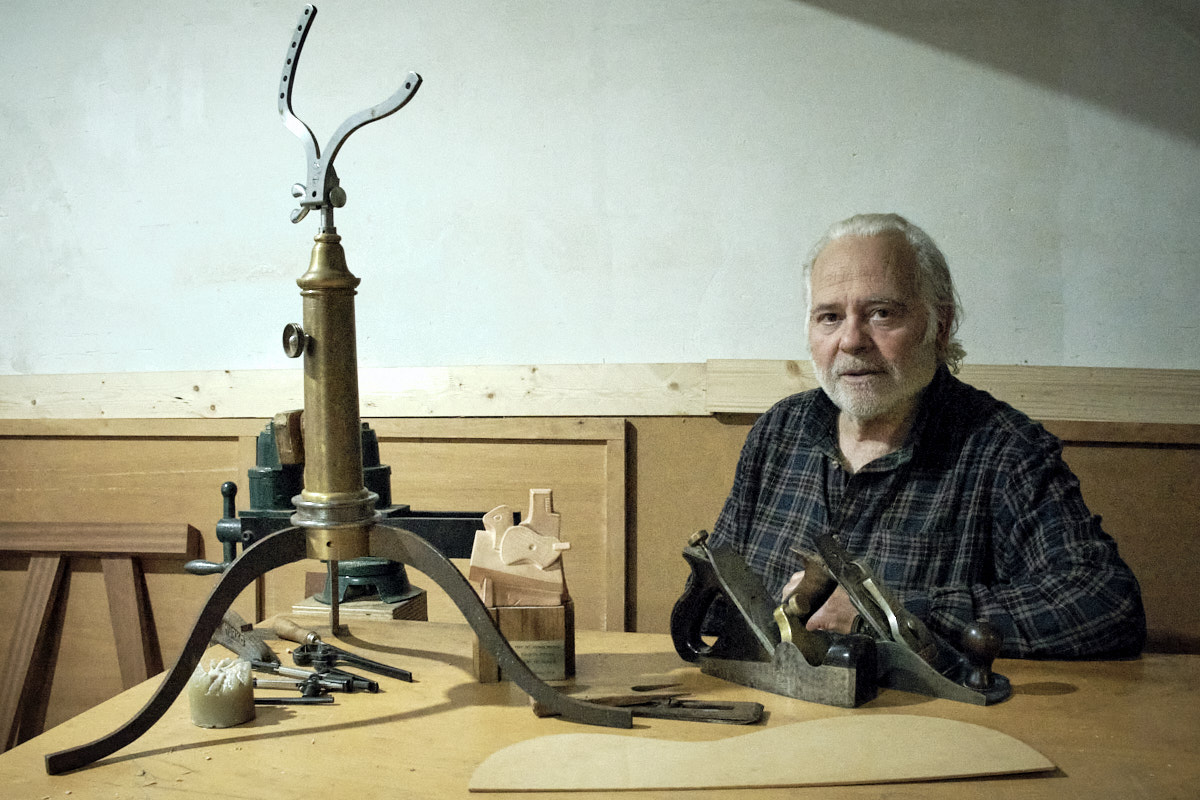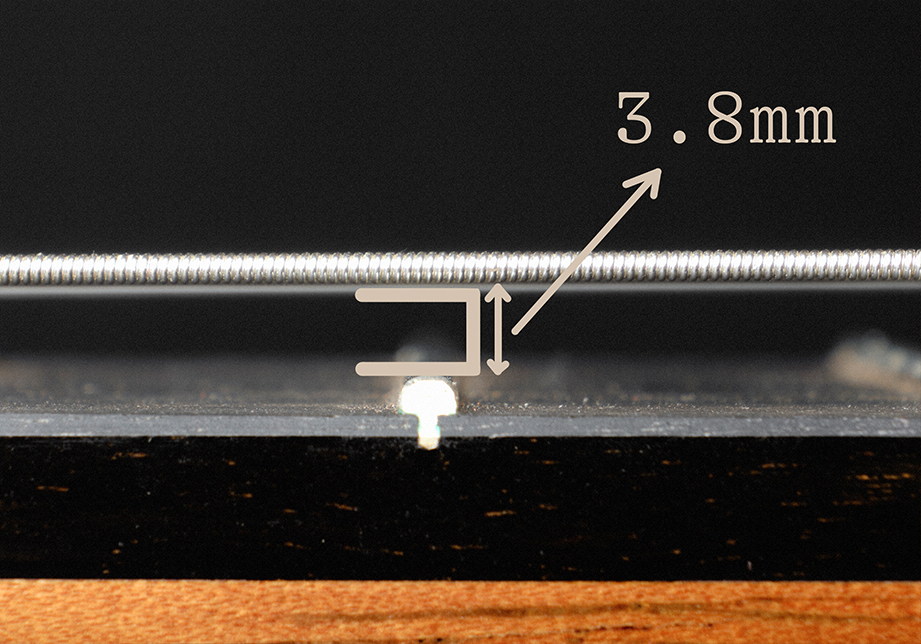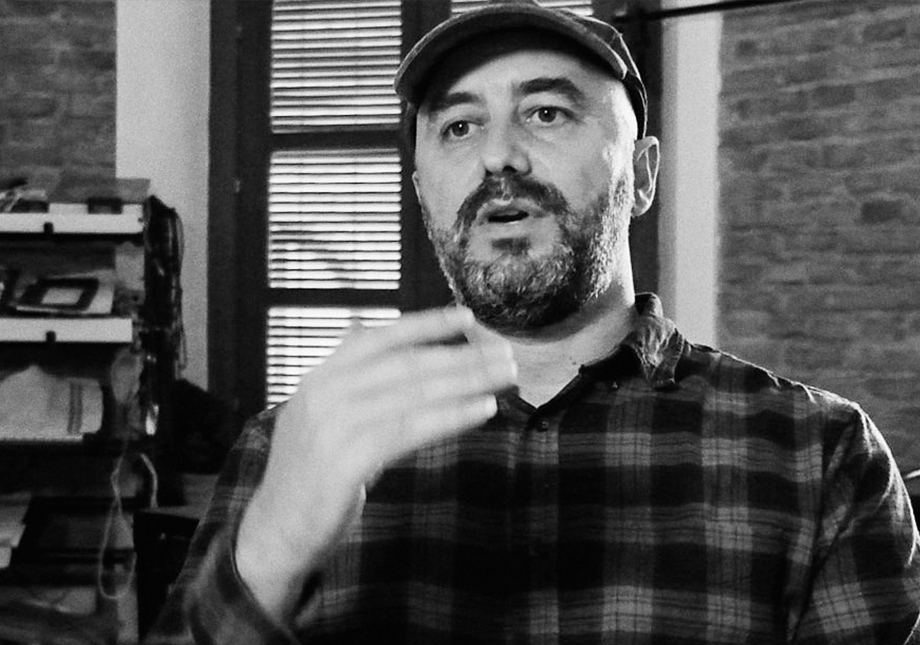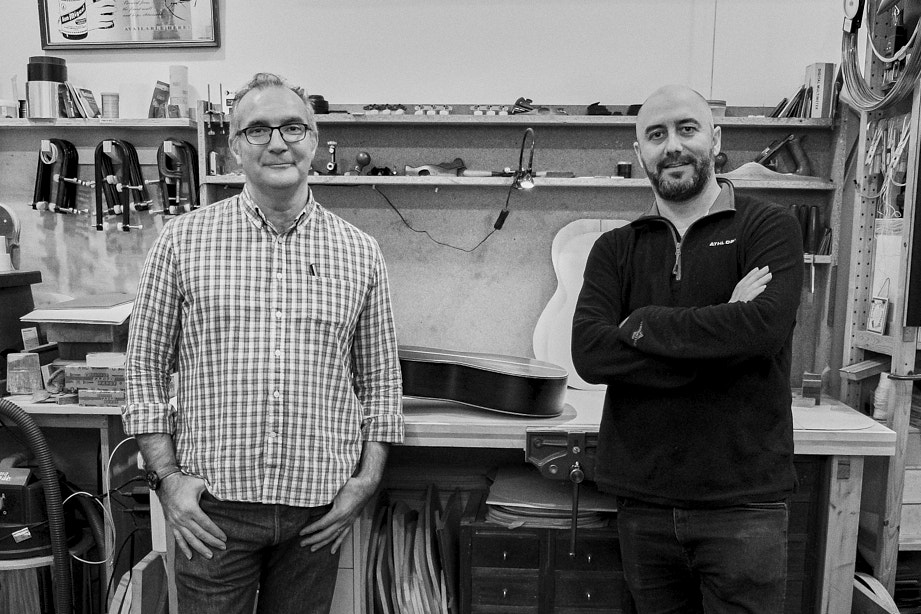No doubt about it.
He’s the best in history
Well, the facts are there.
If we look at the work that he begins in 1842, according to his own words, and ends 50 years later… that is half a century later in 1892
We see that Torres’ entire work has amalgamated all the models of the guitar, from its evolution to its final conclusion.
So, all these models have formed a\Ncanon that is the form of the guitar today.
as we know it today
Is this Torres model still currently valid?
Well, I would say that all the models are currently valid if we consider them as historical designs.
In fact, there is a notable difference between the taste…\Nwhat Julian Bream mentions as
-The change in aesthetic taste- of the guitar from the\Nbaroque heritage who could be Trinidad Huerta himself who has a Terz guitar as a soloist.
till the 11 string guitar that Torres builds for José Martínez Toboso. They are all completely antagonistic models, but they form, as I say, they form a trail, which has followed
with more authority in the evolution of the Spanish guitar. The Torres’s validity, well, it’s being demonstrated not only in the last models of the second period
in Almería, but also the first period in Seville
Because
these models are already being edited as historical pieces\Nwith a great value for historical recordings.
I mean, there are now\Ncontemporary instruments models …
We could attribute the change in some way to
Andres Segovia, let’s assume this, regarding the instrument that we have today of the guitar, which are very complex to use for
the romantic editions. They’re almost, I would say\NI would dare say they’re almost a transcription.
Why?
First of all, because the current instrument body\Nsomehow used by Segovia is a baritone model.
It is a tremendous body with 50 centimetres of length\Nof a template that if we check it, we are going to assume,
with the Terz of Trinidad Huerta
So we say: this? this is a tremendous change.
Yes, yes.
But in the case of Torres’ instruments, which they are around 480 millimetres of body, there we have the perfect instrument.
You may ask: what would be the perfect instrument?.
Well, it’s very simple.
This Torres formula is advocated by none other\Nthan Dionisio Aguado.
Dionisio Aguado García, the master guitarist from Fuenlabrada, goes to Paris.
At the time of 1820-1830 …
Dionisio Aguado had a pecunium of his own, he was a wealthy person and could afford commission his vision of the instruments to the luthiers of France, the exquisite luthiers of France.
So he comes and he takes as his\Nmodel of instruments, that of René Lacote and Etienne Laprévotte.
And these instruments
curiously, let’s say in their configurations,\Nthey have a number of data… for example,
the vibrating surface, which is the tessitura of the instrument and the scale length of the strings, which Torres includes in his work.
There are some instruments in which there is no resemblance, but there is that important piece of information.
Which is a little bit contained.
I mean, eh, Dionisio Aguado himself says
that we have to widen the instrument so that it has a greater projection, but not to the point that it clashes precisely with the human voice. This is also an inheritance from the classical baroque.
So, the guitar since Aguado loses\Nsome references, but leaves others fixed.
Indeed,
The famous instrument made\Nby Torres which is called La Leona…
some people might think, well, today we’re talking about a powerful guitar and we name it as a “cannon” (which sounds a lot).
Well, this guitar is a cannon?.
La Leona was a cannon? No
So? You mean, what is its current validity?\NPrecisely if I were to describe it
I would say that La Leona is “a dial”
What’s the dial?
The perfect response of the instrument to\Nbalance bass and treble. It is the ideal instrument.
The tessitura of Torres’ instrument is a marvel.\NIn terms of tuning and in terms of tessitura.
What does it mean?
We need to talk rightfully of Torres as the Father of the Spanish guitar.
I don’t assume that he should be called the inventor of the guitar. Because then we are leading by a myth…
And that’s unfair.
I mean Torres
what he does is he amalgamates all these models… and he doesn’t destroy them. He manipulates them and leaves them, and he keeps editing them.
Apart from that what happens?… there is also an attitude of
black and white of linking Torres with the concert guitarist Julián Arcas, who is the one who makes him project his work and succeed.
And to think that only…that it forms a kind of a\Nsimple story, of parallel lives, to say Torres and Arcas.
And we’re forgetting such important names, first,
the reference of Dionisio Aguado,
Antonio Cano, Federico Cano, Arcas, Tárrega and after that\Nwe have a list of impressive characters
in the second period, who could be José Martínez\NToboso, who could be none other than Jiménez Manjón…check it out…
So all these instruments\NTorres is making them
in parallel with the music master’s own sense of\Ndesign that the musician master has.
So we can say that a\Ncarpenter invents the guitar? what guitar? .
This is absolutely simplistic. But Torres itself, for better or for worse or for good, he carries in himself both meanings of the term “myth”. he is a myth because of the greatness of his work and he is also a myth
because the biography of this character is told
from the nationalist narrative of the myth of origin.
So that happens from 1930 onwards. And it is precisely Emilio Pujol the person in charge of it. Emilio Pujol, a pupil of Tárrega’s, who describes Torres’s semblance of himself completely isolated from his environment.
One of the definitive progress in the\Ndesign of the guitar was, first of all, the suppression of the guilds.
When the guilds were abolished, the guilds from apprentice to master were constantly repeating models ad infinitum.
Then,
When this breaks down there is a phenomenon, and that is that everybody can build freely
without the guild exams which were sometimes infamous, where they were destined to make the applicant fail.
And suddenly there’s an interrelationship of everything, I mean,
all the visions of the instrument that exist in all the corners of Spain, and even with the European influences.
What happens?
That this really makes up the guitar. Because there’s a series of designs and a series of collaborations that is very important. This also has to be pointed out.
Torres has collaborations.
And he quotes them himself. In 1884 in the Diario de Barcelona he speaks of the excellence of his guitars and he says textually:
“The guitars that come out of my workshops” (with an s).
What relations does Torres have? very simple
It starts in Vera (Spanish Village in Almería) as he himself says
He signs up for the carpenter’s guilds.
And he says to make guitars, he means; what is the guitar made of? of wood?
Well I want to have a knowledge, but before I’ve had a musical training, he says with Aguado
So that’s the perfect profile of a guitar maker, a person who has
carpenter’s or cabinet maker’s skills, and minimal musical training. Torre’s evolution from Vera… You will see that he says where he begins to build, I repeat,
from his own advertisement in the Diario de Barcelona\Nin 1884. It is that in 1845 he first moved to the capital (Almería).
There are already labels that have been confirmed as dating from 1852
the official Torres label. And then he makes\Nthe qualitative leap and moves to Seville.
He could even have gone to Madrid, as the oral tradition says, to present his guitar in 1852? There is an episode that could be a sort of romantic slant on the character’s life, in which it is said that
he was arrested for his involvement in the assassination attempt on Queen Elizabeth II. What does a simple craftsman do with that kind of act? No
It may have been the date it is related to as a mnemonic device 1852 the year in which an attack was made on the life of Queen Elizabeth II, which was true, it was the year in which Torres began to build.
It could have been moved to Madrid? it is possible because\Nlater it appears in 1865, already advanced, with the “shuttle”
we would say that it is said nowadays,\Nfrom his workshop in Seville to Madrid.
In fact, he appears in the press already making tamden with Julián Arcas. That is to say, that is right, this is not fantasy
This man travels to
Madrid, he goes to Seville, he goes to Almeria, and then finally.. in 1882 that this great tragedy takes place, right?
Julián Arcas dies. Torres again seeks the support of the Cano family and goes to Barcelona.
And there you have for me the tremendous international projection of Torres’ work, because in 1888 the Universal Exposition of Barcelona took place.
And who are the characters?
Tárrega, Federico Cano himself, Baldomero Cateura.\Nso we’re talking about Torres is infinite as far as collaborations are concerned.
It would be interesting to define what traces they have left in his work
all this extensive and prestigious directory of music masters who went to Torres workshop
And somehow you can see,\Nuh, how the work has been projected?
Totally.
For example, there are guitars that are known to have been\Ncommissioned by certain musician masters.
Other instruments, therefore, must be treated as\Narchaeologically as a piece of plunder.
I mean, all of a sudden a collector brings out a model,
a model comes out, and we don’t know who it belonged to.
Who played it.
We can only speak in the likeness of those…
I call archetypes, I call those commissions in archetypal position , for example, Julián Arcas with La Leona,
Federico Cano with La Invencible … which is even\Nhistorically registered as their property.
Jiménez Manjón with that 11-string guitar.
All these instruments are dated
authenticated and belong historically to the\NTorres’ legacy influenced by these music masters.
An important characteristic of the\Ninstruments is their value as a work of art.
It’s said, well, at the level of music, the guitar is
an instrument of music, and they’re the support of\Nan immaterial art which is music.
But they themselves are also works of art.
Why is that?
Because they contain a symbolic meaning.
In this case, the symbolic meaning that the instrument has\Nthe instrument is completely captured in the use of speculative geometry.
Meaning those traces of the instrument that maintain
symbolic meaning. The square,\Nthe triangle, the golden section…
All this has made up the guitar’s template.
And for those of you who think, well, this may be an anecdote.
You have to say no, for two reasons. Because while the golden section in architecture does not condition the structure of a building. And the symbols may have been forgotten of
the instrumentation of that geometry, but they are still a tool.
An octave is half the length of the fretboard.\NAnd it is a tool. It has been forgotten, perhaps, that Robert Fludd,
the alchemist, said that if the octave…
Okay, it’s forgotten,\Nbut that’s still a tool.
So,
How do we see that in Torres’ work?
Well, here it is. Simply\Nby proposing a restitution of the instruments. And some of them are tempered.
For example, the proportion advocated by Dionisio Aguado is four to three. And Torres never uses it.
He uses an approximate tempered ratio of 13 to 10.
This has been analysed over time, eh?
Romanillos mentioned it, although he does not go a step further and does not establishes proportions, but it’s simply known
that these proportions are those of La Leona.
La Leona has a, let’s say, a short trail related\Nwith some authors, in this case Julián Arcas.
But then there’s another model that has a\Ndifferent approach. Many authors have said:
Come on, if there is no canon here, how can there be a canon?
Yes there is. What’s the matter? You can get on and try to define it. That’s what I’ve been doing all my life.
I’ve had a fascination
precisely because of the recovery of the templates (plantillas) to fix the model. Because everybody is already copying it in such a way… that there comes a time when it does become mediocre.
So here we have, for example, one of the beautiful points of the template is precisely the waist.
The waist in La Leona is half the length of the body.
We are talking about
of the ratio in octaves.
The waist is half the length of the body,\Nwhereas in other slimmer models,
it would be this model, which is precisely from one of his collaborators, Miguel de Moya. Where the golden section appears.
The golden section is represented here. It means that
The break of the waist, which in the normal guitar\Nis a degradation of two and a half times in length,
is narrower and rises to a golden section proportion.
They are models of Torres which have the same tessitura, the same vibrant surface,
but which are different visions of two guitar makers who have collaborated. But they have a different opinion of the instrument.
This work,
one of the motivations that I had,\Nbecause I had a background in industrial modelling, was precisely because of my family ties with the Moya family.
So, all these templates have a\Nfundamental information. So that when
a guitar maker, any guitar maker makes, so that the end result of what he makes is
the vision that he has more or less of the information\Nof Torres’ work. And there is an important documentation now of top restorations of Torres’ work.
So, within these measurements, within this register,\Nit can be established, effectively, that there is a series of proportions that made up the instrument.
On the other hand, these guilds\Nthat had a certain mystical cut,
we have to assume it is history, they were\Nrelated to Freemasonry.
And for them the sound…
Geometry is the synergy of sound. I mean, it’s not like\Nall of a sudden on a whim, they said let’s make this more beautiful…
and we’re going to mark it with the compass…
No no. The compass in some of Torres’ instruments that\NI’ve analysed,
one of them, precisely the Torres guitar that is located\Nin the Centro de Documentación Musical de Granada,
the trace of this instrument is part of the position Ad Quadratum (Within the Square), that is to say, it is a square in which the compass, all the arches of the curve that forms the shape of the guitar,
are taken at a harmonic centre.
It is impressive.
So, well, at a certain point you can say;\Nwell, you can more or less copy the guitar with a certain amount of tolerance?
Well the answer would be the same as:
we have the tempered scale of the fretboard\Nand we can do it more or less?
Yes, but what will be the result?
And the logical thing is that we say, well, I’m going to use the rule of such and such… So that perfection of the instrument, of the scale lenght, is implicit in the body.
of the guitar for obvious reasons.
The crossbars have been documented\Nto be part of the tuning of the instrument and they have a tuning function
I mean, we can’t place them “in\Nsome way” because then we’re not really getting the fantastic sound that the instrument has.
Another maker who has edited Torres? Simplicio. Behind all that precious
amalgam of drawings, of ornaments… things that Simplicio does, there’s Torres’s template.
Besides, it’s the edition of a tremendous cabinetmaker (Simplicio) who has been a pupil
of Enrique García. Enrique García has been the best copyist of Torres in history.
of Enrique García. Enrique García has been the best copyist of Torres in history.
Talking about the symbolic meaning
In this case, we have one of the typical Torres rosettes on a singular instrument.
So, what has been called at the popular level\Nherringbone, which is an ornament of marquetry, of inlay. It is in fact,
The Laurel of Apollo, which in this case is heraldically placed from bottom to top, half right to half left.
And this was only done by Torres to those that he\Nconsidered to have the degree of music master.
It would not occur to him to do it for an\Napprentice or a beginner, to make him a guitar so ornamented with these symbols that are manifest.
On the other hand, the colours that Torres uses are always from natural woods and when they are dyed, he uses strictly white, black and red,
which are precisely those the colours of alchemy. Plus the green, which also has a meaning, it is often said in masonry, the Green Lion, the vitriol, which is precisely a
a dye that is used, which comes from this very powerful\Nvery potent acid of vitriol, in guitar making.
The Moya’s who were collaborators with Torres used this acid which comes from Sierra Alhamilla (Almería), in a natural way and they used it to dye the wood.
It turns out that
this combination of colours that have a specific\Nmeaning, to the lay person
well, they can only appreciate it as\Nsomething like a beautiful classical ornament. but it did have its symbolic meaning.
In fact, all of Torres’s guild mates,\Nwhether it’s the Soto’s, whether it’s the Moya’s, whether it’s these apprentices that he has here later…
are persistently using these colours red,\Nwhite or black, white, green on the rosette.
Miguel de Moya when Torres dies\Ndo you know what it says on his label?
Segundo Moya (Pierre’s slip of the tongue. He means Segundo Torres)
He is not going to present himself as an apprentice of Torres for two reasons
His status is far superior to that of a village carpenter who is a carpenter who is Torres from Vera,
because we talk about one of the great carpenters of the city, who have the whole city sowed with works in very important buildings.
So this man, evidently, he appreciated Torres,\Nhe took some commissions from him, but he’s giving him a special distinction.
Indeed,
Cabinetmaking in the 19th century was one of the fine arts.
That man starts making with official label in 1848, and survives Torres. Which means that the label he put on later
means that he won’t tolerate anyone who is evaluating his work telling him that he’s an apprentice. No no, he’s another Torres.
Of course, you can see it.
And it’s precisely in that evidence, of the accuracy of the\Nthe trace and some aspects of the internal structure
of the instrument. That, significantly, now we’re talking about fashion styles. While Torres was
concerned about the projection of the\Nthe power of the instrument,
it turns out that Miguel de Moya was worried about the opposite, for the romantic guitar, which is why we see some of the instruments that he built with poplar harmonic bars.
If you tell me: Joaquín, would any guitar maker ever think of using a poplar bar? I would say that it’s an aberration because it’s going to sound like not much
Yeah, but if that person is doing that and he’s a connoisseur, he knows he doesn’t want to bother with that guitar, it’s a perfect, delineated romantic guitar.
So there you have it that those templates\Nthat he owns are his.
And the collaborations with Torres are other, but\Nstill we have an important differentiation.
Let’s ask ourselves now something very important,
which is in relation with the character’s history.\NTorres when he makes La Invencible.
we are seeing each other with a guitar\Nstunningly perfect. But that man…
Look how old he was already. But not only\Nthat, in the will of Torres in 1891
beware. The first fortnight of the\Nyear 1891 in Torres’ will
is so physically deteriorated, that there’s a post it says that he agrees but that he cannot sign it.
Check out
So, what are the labels dated 1892 doing?
“well… they were not finished”… no no no…\NWhat is Torres doing placing an advert
the family, sorry,
saying moving the workshop to Calle Relámpago?
Why are they moving the workshop? very simple, because this is logical and does not fall within the scope of forgery, but rather of the idea of the relatives to perpetuate that name.
So, we’re going to continue with the workshop\Nbecause first we have a lot of commissions
And secondly, there are the people there who are making for him.
they can keep making.
In fact, there is something
we could call it chilling or almost novel-like.
But there is a very important detail, which is that it appears in 1893.
a greeting, a card, with the image of Torres and the date of 1893 telling friends that he has just passed away. No. Torres died in 1892.
Where does this card appear?\NIn the house of Federico Cano in Barcelona.
The music masters, moreover, are the first ones to order instruments for their students from Torres.
And he is a famous person that, obviously, we can’t say,… well, why this man has hidden this in 1893? if in 1892 Torres’ death new appeared in the press.
Yes, but, with 60% of analphabet people in the country…
that was not known in other society circles.\NThis seems anecdotal …
but it confirms two things
First, that Torres is actually\Ncollaborating with officials in the workshop.
And secondly, popular instruments, simply\Nthe gesture of a person, of an antique dealer, for example
of somebody’s
well-disciplined, can tell you perfectly well that\Nare not the product of the same hand
We take La Emperatriz which is one\Nof Torres’s commissions for Moya
and we can say, how is it possible that this instrument\Nwith the age of this man it has this tremendous perfection?
He didn’t make it.
I mean, physically they are his models,\Nbut that instrument…
What about Tárrega’s?
1888. We are talking about three years before\Nhis death, and he makes Tárrega’s guitar which is today considered a canon.
He died in 1892… He was born in 1817. He was around 75 years old.
We’re talking about the fact that he was already at the time of the 19th century… that man had diseases, in fact,
So he had in his life probably helping his father, drinking water from wells… a long-lived man but in poor health.
In fact he died of abdominal cathexia…\Nof some cholera….
We don’t know, but this man had ailments.
La Leona, Torres in the second period,\Nbecause it seems that he doesn’t edit it, because La Leona really has a sound response component
which is contrived. La Leona is an instrument of a tessitura not that big, which is supported by the Tornavoz
and by a manipulation of the high bars so that it has a response that really, as a design in itself, it doesn’t have.
So, the last model of Torres, as I said, is the\Nabsolute perfection. Because the model no longer needs the Tornavoz.
It’s got enough tessitura, eh?
And he’s got that response…
I’m telling you, aquilated, so pretty…
But it’s not a cannon, Torres’ guitar is not a cannon.
It’s “The Dial”.
Right now it’s being considered\Nas something authentic
that the Torres model is being put back in value, but in all its aspects, the romantic for historical recordings,
as well as the last model as an instrument for today’s needs. This is also an special patrimony for very few guitar makers.
There are very few people who can stand on a workbench and say, I’m going to make a Torres replica.
Well, a Torres replica? umm
We’re talking about the top level also for the guitar makers in the sense that they dare not only to edit
but that we are going to copy this
and edit? ummm that’s ….
that’s another level
Torres’ instrument is designed with anthropometric measurements. With the Almeria stick (vara de Almería), specifically 833 millimetres.
what happens?
Look, what a mistake…
Well, the ratios that… this has been\Npublished. It’s not my discovery.
That’s right.
It was that in the last model
The scale length of the instrument, of nine-parts would be five for the lower body part of the guitar.
Look how impressive.
If it’s 650, divide and you get… or 648…and you get 360mm
As it turns out, there’s not a single Torres instrument,
(and there are with copies), with the 360 measure, why?
Because the stick of Almeria (vara de Almeria) is 28 inches, it is 648.9 so on… and it is not enough.
well, some people say: “well, we’re going to improve it\Nwell, because umm… the Torres fret marks is not a standard…” Is it not a standard? ok
And we took the frets off and we put 650. No! Wrong.
That guitar has 649 something. And the lower body width is 357 with something.
And look at that, it’s so important…
And now go to the bar because it turns out that the inside bar
is also that size.
“Well, if it’s three millimetres…”
What happens with the sound?
The sound goes from low to high-pitched
from low to high-pitched
When they act sympathetically inside the body, the bars can be harmonically dragged,
or it can leave them dead.
If I spread them too far apart, the bars,
The sharp response is not going to reach them,\Nso you say look what a copy of Torres…
Look, I don’t have an opinion…
Sometimes they ask me: this guitar?…
I don’t…
I don’t have an opinion… I mean, if you think you’ve copied it… well, ok …
In fact, here’s an example
The most important example is precisely\Nthis guitar, which is no longer by Miguel de Moya.
It is made by his nephews, the Moya brothers.
Well, this guitar has already corrected the width to be compensated for the 653,4 . Then…
So, these guys (Hermanos Moya -nephews-) are failing in their assessment of what the Torres model is? no way, they’re editing it. And they’re editing it with the millimeter measurement.
Look, three, six, three. Four, eight, four. That’s two\Nmillimetres longer in the body and three millimetres more on the width.
And well, just recently…
Not long ago, Some came out with a ruler from a great designer from the United States of a tempered scale. And after seeing it
this detail of the tempered scale of the guitar instrument.\NAnd in Torres, especially since the Sevillian period,
so it is marked with the stick of\NAlmeria and the scale length is lower than 650, and what Aguado advocates with 28 Castilian inches.
I was surprised talking about this Moya’s\Ntemplates, that I took from an instrument that was also repaired.
That this ratio that there is of nine parts for the scale length … that would be five parts for the lower body width,
In Torres they don’t reach 360 millimetres because he’s using those measurements which are measurements that are smaller. And the current rectified measurement
of this ruler by Irving Sloane, an American musician involved in lutherie,
he printed this, perhaps one of the first rulers to be tempered and verified by computer.
And what comes out?
So it comes out exactly 653 millimetres and so on …
And it would be corrected to 653. Well, this template already had this. they already had it in 1920. From the Moya Brothers. (Miguel nephews)
This template already had this rectification on the lower body. So, as I said, to edit an instrument, to copy an instrument, it’s not necessary…
It’s not just to reproduce it in its measurements and its defects, but to edit it and to really see how you deal with this incidence of the design. Otherwise, it’s not achieved.
Well, let’s see, they say: I want to put a 660 scale lenght…
No, no, no, no, no, no,
Don’t put a 660 scale lenght in it. The 660 scale length exists in some of Torres-Moya’s guitars that are published
It is a feature of the Moya’s. With which\Nwe have to see, that the internal bars has been prepared for the response of that scale lenght
but we can’t interchange it in the same way\Nas we can’t change the frets position
So, that’s important.
Not only do you have to put the\Nvalue of the instrument by preserving it, but also by editing it.
Because sometimes there are instruments that some says:\Nthey’re disappointed because… this instrument is an original Torres, but the way it sounds… umm…
Somebody manipulated that instrument. And He has thought with the arrogance of the one who thinks he’s an authority…
Well, he has modified aspects that are vital to analyse it and value it. The very fact that La Leona
This gentleman he says: “it seems that at fret number 12 it was starting to fail… ” What? That it was starting to go wrong? … Cause you were thinking about the 650 scale lenght,
and they’ve taken the bridge and undercut it to make it two millimetres longer. Wrong.
You have to check the frets’ measurements and preserve that measure.
And it was also gut material, wiring one… so…
Suddenly they start manipulating something,\Nthinking you’re going to make it better and you’ve destroyed it!.
As I say, it’s like a car.
I give the industrial example that everybody knows.
I can change the wheels, but if it’s a small model and suddenly I put some big wheels on it, I’m going to break down the whole engine, because it’s related…
Maybe it’ll last me two days…
It’s breaking down the original design.
So, the music, all those parameters that are in the original instruments can’t be changed.
If there is any experimentation, it has to be done in the editing of the copy.
Why?
Because that will frustrate people, because there are people who are “expert” people who say: “well, this instrument
we’re going to restore it and we’ve done all these things to it and it doesn’t live up to expectations.
But what have you done?
READ MORE
READ LESS






